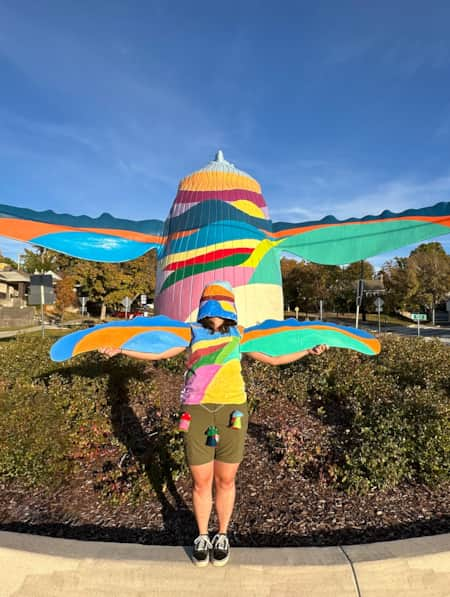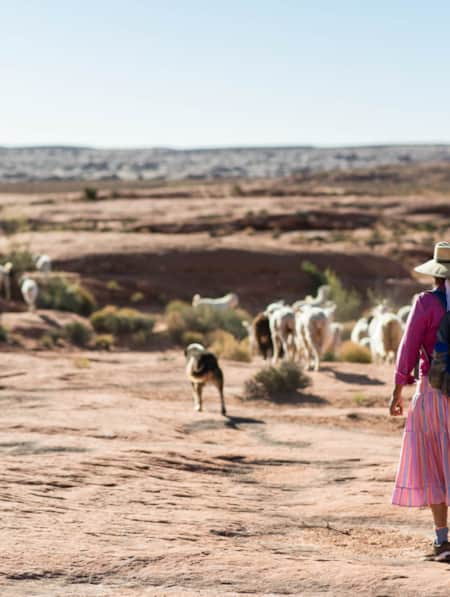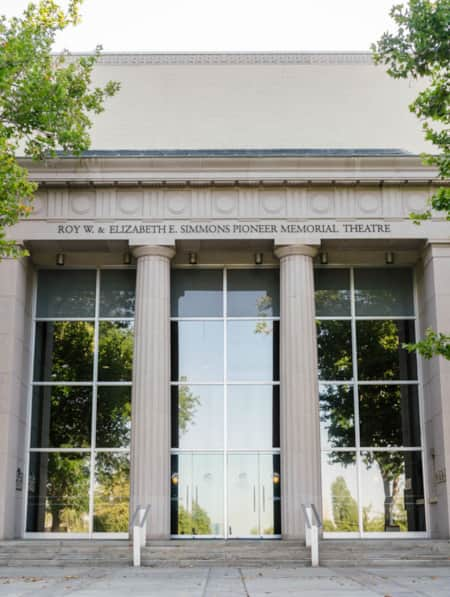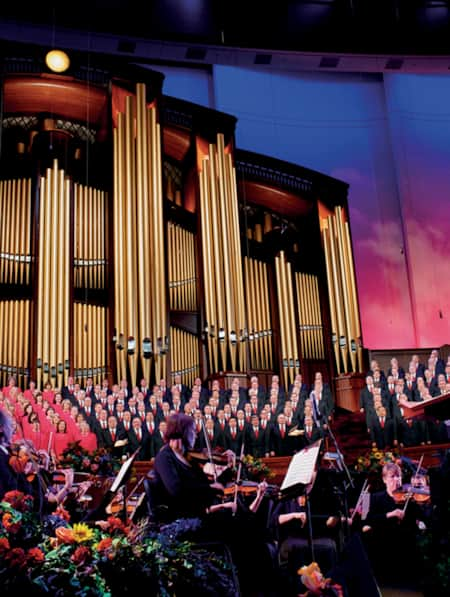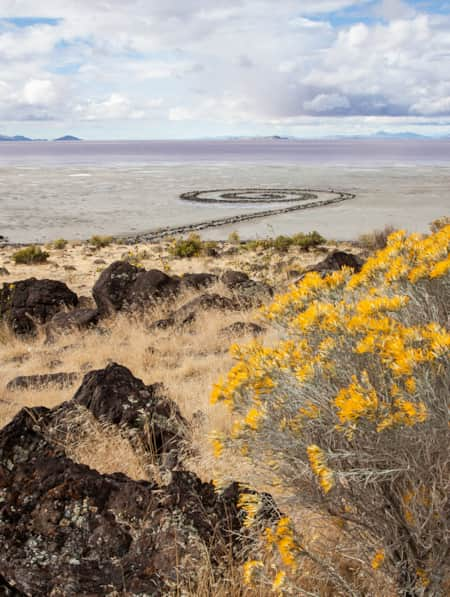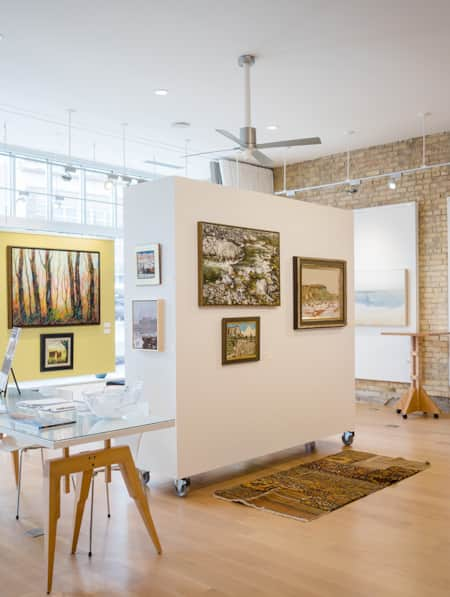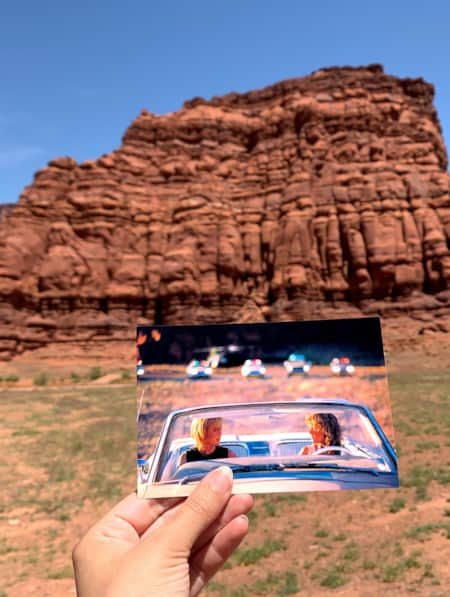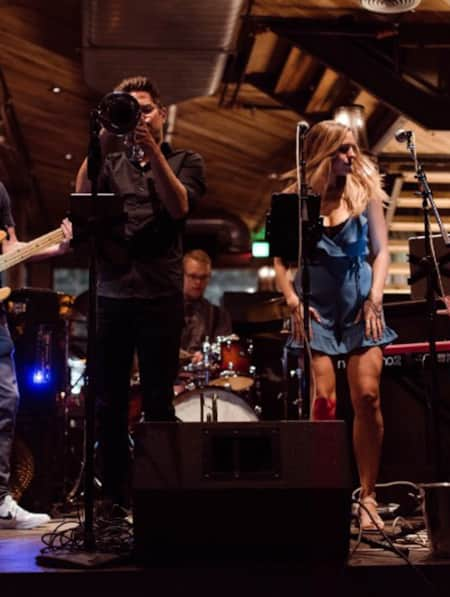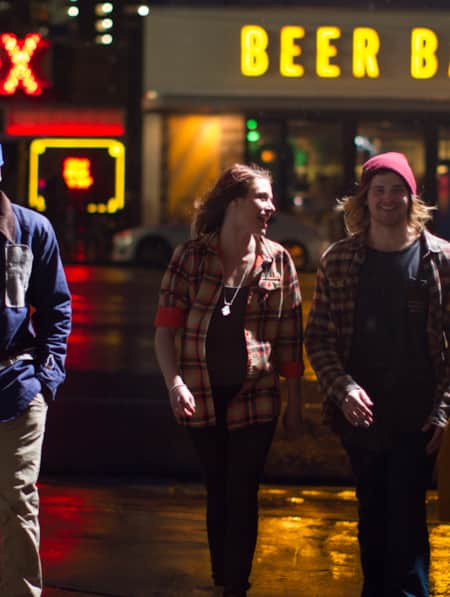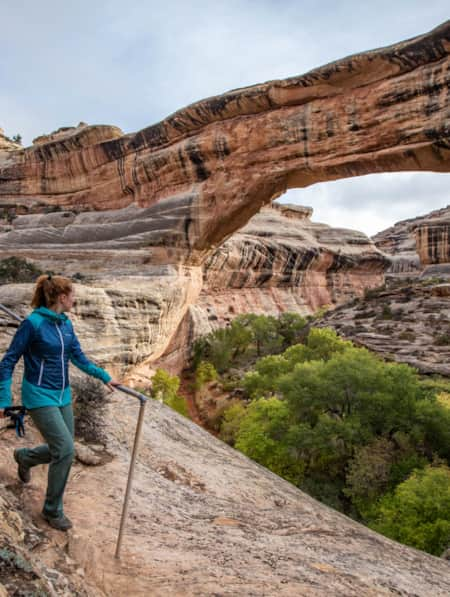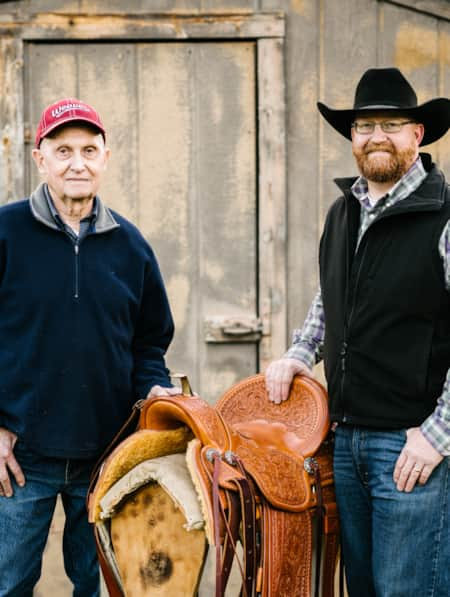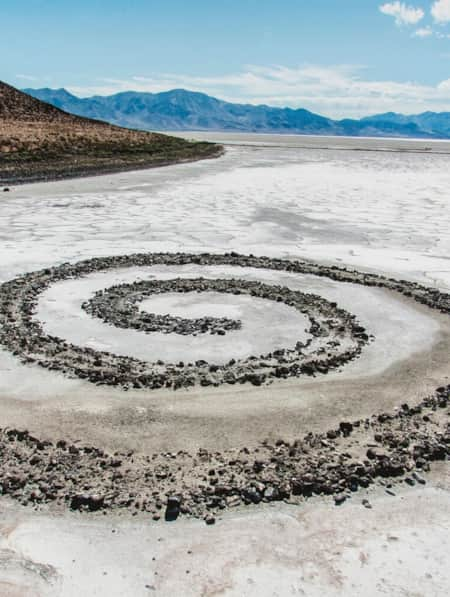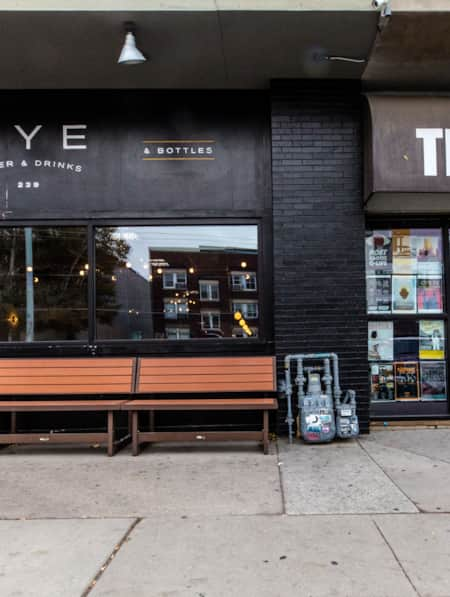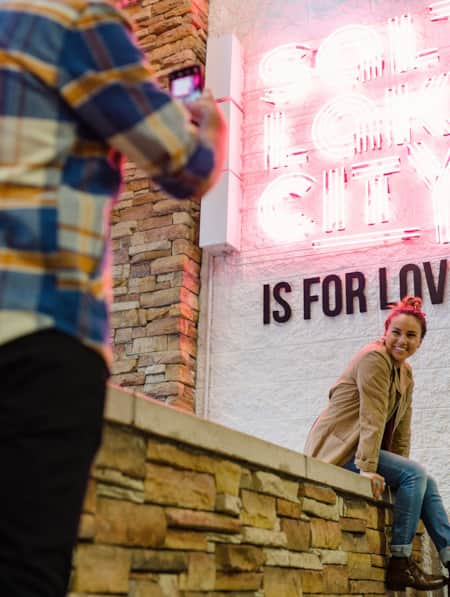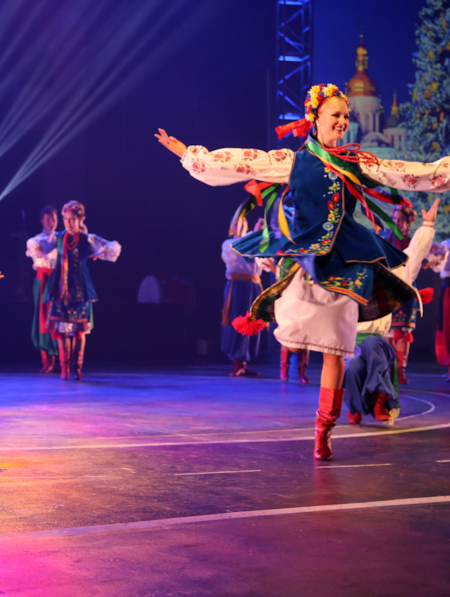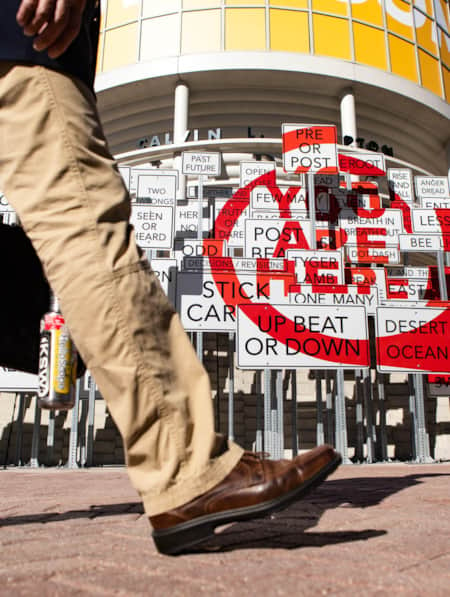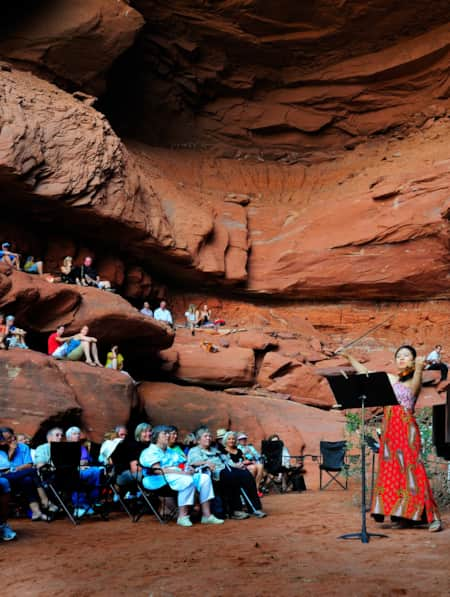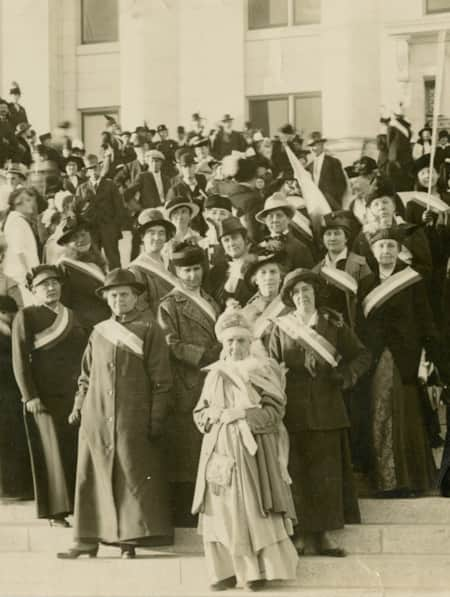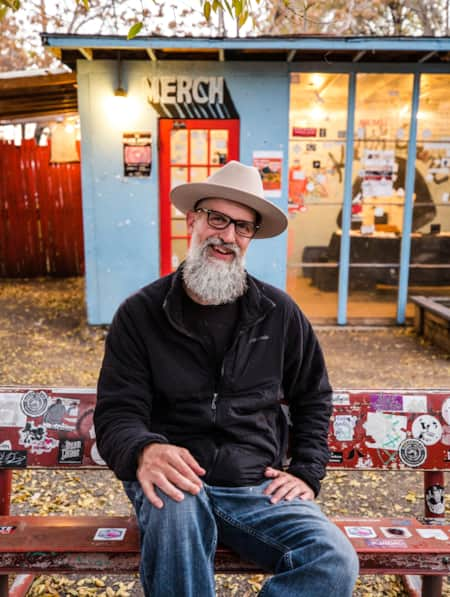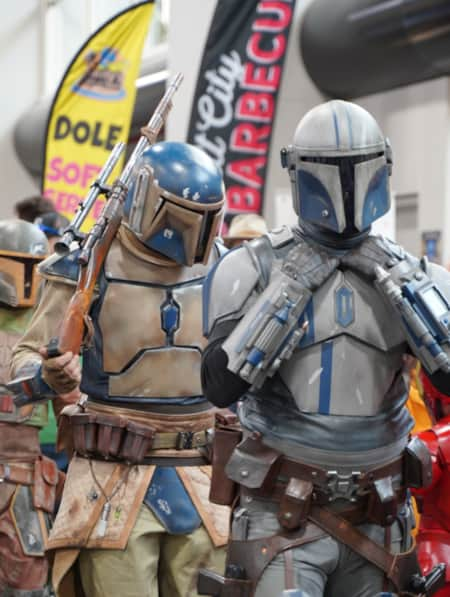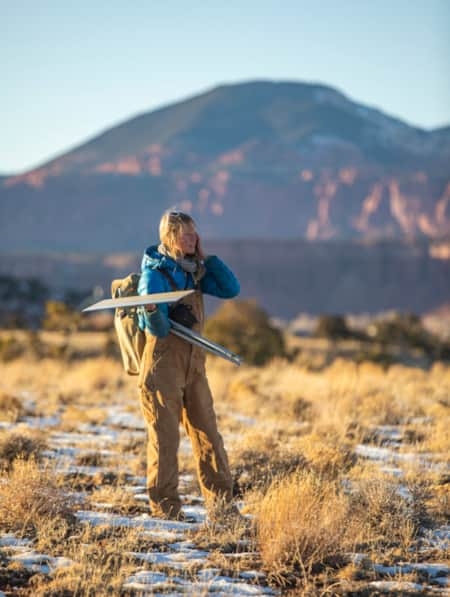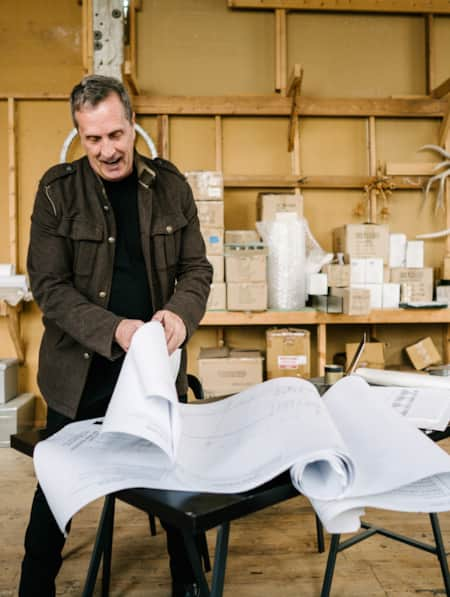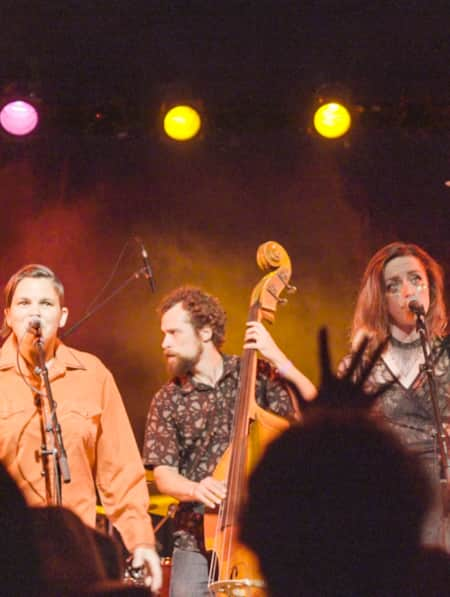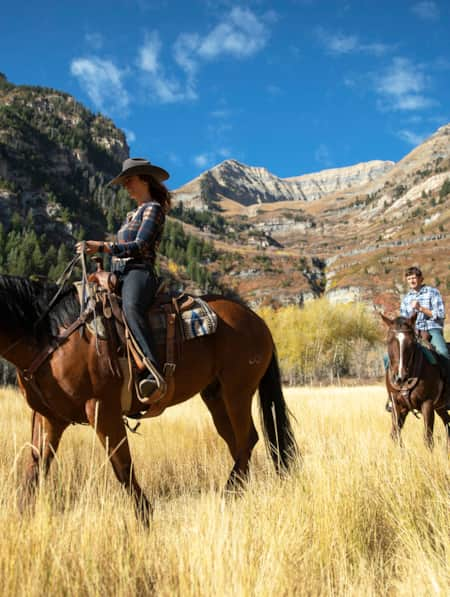Experience Utah's Wild Side with the Wildlife Walls Mural Trail
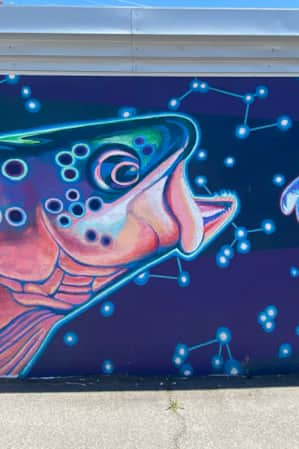
Want to experience Utah's wild side? Thanks to Utah's Wildlife Walls, the state’s native creatures may be closer than you think. Local artist Chris Peterson's towering murals of native trout, desert tortoises, grizzlies and golden eagles are bringing the wild directly to city streets across the state.
And for those looking to venture further, the Utah Wildlife Walls Mural Trail connects the impressive murals with wildlife viewing opportunities across the state. It’s a unique and informative way to experience both the art and the wildlife.
Each mural is a vibrant tribute to the species that have shaped Utah's identity, from the elusive razorback sucker and Colorado River cutthroat trout to the famed Bart the Bear. And after viewing the 14 and counting mural locations from Logan to St. George, you can spot some of the featured species in their natural habitats.
So, pack up the car, gather the family, and get ready to explore Utah's wild side like never before. Just remember to follow the principles of Leave No Trace, and keep the wildlife wild. Respect their home by only observing from a distance. Save human food for humans, ensure pets are within your control and know local fishing, hunting and boating guidelines.

Bonneville Cutthroat Trout Mural
2065 E 2100 S, Salt Lake City
This massive 120-foot “Bonnie Wall” mural celebrates Utah’s state fish, the Bonneville cutthroat trout. Once thought extinct, these native trout were rediscovered in hidden streams and have become a symbol of resilience thanks to decades of conservation work. The mural features the fish’s signature reddish-orange throat slash and speckled body, boldly stretching across The Neighborhood Hive wall in Salt Lake City. This mural highlights a success story of native species recovery, and it is the perfect spot to kick off the Salt Lake Mural Trail.
To spot these trout in the wild, visit Big Cottonwood Creek or Little Dell Reservoir, where shaded alpine streams still support healthy populations. Interested to drop a line? Review Utah’s fishing regulations.
From the Neighborhood Hive, head west on 2100 South to the Sugar House Post Office on 1100 East for the Sugar House Peacocks Mural.
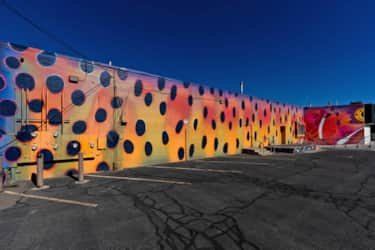
Sugar House Peacocks Mural
1953 1100 E, Salt Lake City
This giant peacock mural, tucked just two doors down from Sugar House Coffee, features two bright peacocks set against a dreamy, tree-lined backdrop. While peacocks aren’t native to Utah, they became part of Salt Lake’s story thanks to Allen Park, a quirky neighborhood where Utah's first live wildlife exhibits were built and exotic birds still roam free.
Allen Park’s history helped inspire wildlife conservation efforts like Tracy Aviary and the Hogle Zoo. When thoughtfully designed and ethically operated, zoos, aviaries and wildlife parks can play a crucial role in both conservation and education, helping visitors see and connect with animals they might never encounter in the wild. They can help spark curiosity, empathy and a deeper understanding of biodiversity.
You can still hear the high-pitched calls of peafowl in Allen Park today, or spot them roaming through Wheeler Historic Farm.
From the Sugar House Post Office, head further west on 2100 South until 900 East and the S-Line to see the HawkWatch Golden Eagle Mural.
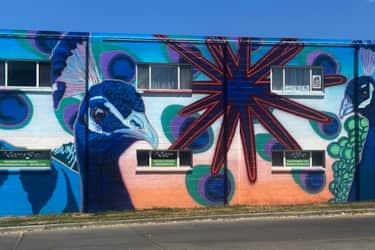
HawkWatch Golden Eagle Mural
857 Simpson Ave, Salt Lake City
The HawkWatch Golden Eagle mural shows a golden eagle soaring over the ranges of the Great Basin, situated next to smaller bird sketches drawn by local Boys and Girls Club after-school kids. Golden eagles are Utah’s state bird of prey and a top predator, often seen gliding above cliffs and open spaces. The mural pays tribute to HawkWatch’s mission to study and protect these incredible birds. (Read: How a Window View Led to a Career as a Raptor Biologist)
Golden eagles can be seen in the wild at Antelope Island, Kyhv Peak Lookout or soaring above the Jordan River Parkway.
From this mural, you will head north along 900 East to reach the Queen Ursa mural in the lively 9th & 9th neighborhood. Or, another fun option is the raptor-to-raptor ride — a bike route that starts at the HawkWatch Golden Eagle mural, follows the S-Line and Jordan River Parkway bike paths, and ends at the Midvale Golden Eagle mural. You might spot real raptors overhead along the way, turning your mural tour into a live wildlife experience.
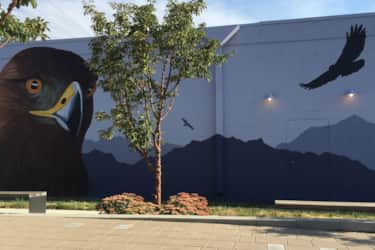
Queen Ursa Mural
899-875 S McClelland Street, Salt Lake City
In the heart of the artsy 9th & 9th district, the Queen Ursa Mural adorns the east side of Hip and Humble. This mural shows a mother black bear and her cubs surrounded by gorgeous floral patterns sourced from cultural artisans around the world. This mural was created to embody the themes of feminism, community, color and inclusion.
Black bears are Utah’s only remaining wild bear species and are often seen in forested mountain and wilderness areas. Visitors are not advised to seek out black bears. But to experience the area they call home, you can visit Wasatch Mountain State Park.
After taking in the beauty of the bear mural, cruise west toward downtown Salt Lake to discover the Edison Street mural.
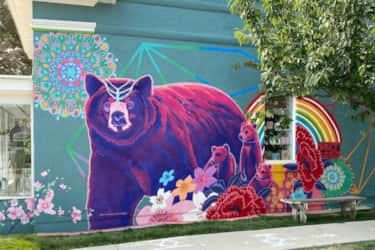
Edison Street Mural
299-261 S Edison Street, Salt Lake City
The Edison Street Mural packs a lot into one wall: bison, native bees, moose and a grizzly bear, all intertwined in a scene that blends Utah’s wild past and urban present. Located on Edison Street, the first electrified street in Salt Lake City, it ties together the city’s industrial history and its natural heritage at the time the first bulbs flickered on. When electricity first hit Edison Street, grizzly bears still roamed the surrounding mountains and valleys. But while the city and its population expanded, they were pushed out of the state, with the last wild grizzly — Old Ephraim — shot in Logan Canyon nearly 100 years ago.
Today, bison roam Antelope Island, moose at Silver Lake and the pollinator gardens at Allen Park welcome native bees.
From Edison and Broadway, you will head southwest down Main Street to a cluster of wildlife walls in South Salt Lake.
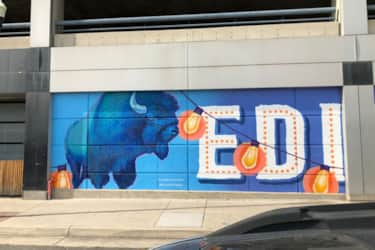
Frogwater Mural
2460 S Main Street, South Salt Lake
The Frogwater Mural is bold and unexpected: a brightly-colored relict leopard frog in the sites of a rising monster brown trout, set against a circuit board pattern. The mural explores the tension between coldwater species and their warming habitats in the American West. As temperatures rise, brown trout — introduced from Europe and now widespread in Utah — are outcompeting native fish like cutthroat trout.
Brown trout, an angler favorite in the state, are able to tolerate warming waters that cutthroats cannot. The relict leopard frog, once common in Utah, is now extinct here and survives only in a few isolated spots in the Mojave Desert, including the lower Virgin River. This piece reminds viewers of how climate change, habitat loss and species introductions collide to reshape fragile ecosystems.
Next, visitors can jog a few blocks north along West Temple to find the unexpected Utopia mural.
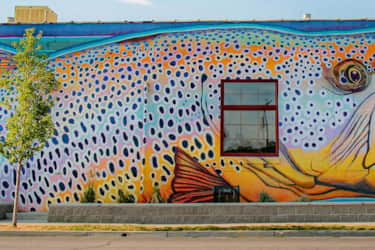
Utopia Mural Project/Space Trout
2150 S W Temple Street, South Salt Lake
The Salt Lake Mural Trail includes the Utopia Mural Project. This was designed and painted over two years and in three phases, covering five walls of the building and stretching more than 200 linear feet. From a vantage directly in front of the neighboring Shade Brewing, an anamorphic Super 8 camera sprawls across the east walls. The message, “Welcome to Utopia; don’t miss it” is the artist’s admonition to celebrate and relish the wildlife encounter we enjoy today. Rays and constellations wrap around the corner into an alcove where a mashup of “Death-star Griz” snarls at a neon colored “Space Trout” about to swallow an astronaut.
A stroll to the far west wall of the building reveals a 65'x25’ mural of another monster space trout chasing a comet through some planets. From the Trax station vantage, a few hundred yards to the west, it looks like the big fish is about to eat the little fish. It’s playful, strange and thought-provoking all at once.
The mural’s “Space Trout” nods to brown trout, which can be found in the blue ribbon fishing waters of the nearby Provo and Weber rivers.
From Utopia, hop on the Jordan River trail or I-15 and head south to Midvale’s old Main Street, where the Salt Lake Mural Trail wraps at the Aguila de Fuego mural.
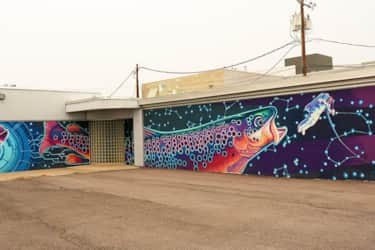
Golden Eagle: Águila de Fuego
7711 S Main St, Midvale
This Midvale mural tells the story of Phoenix, a golden eagle that survived a devastating wildfire as a fledgling. Painted in fiery reds and yellows, it reflects both destruction and resilience, reminding viewers of how wildlife adapts to a changing world. It was created as part of the Los Muros on Main festival in 2023.
Golden eagles are often seen soaring above Antelope Island, the Jem Trailhead and Kyhv Peak. Look for their seven-foot wingspans and 200 mph dives.
This mural also marks the end of the Salt Lake Valley portion of the Wildlife Walls Mural Trail. From here, the trail continues statewide through some of Utah’s most scenic regions.
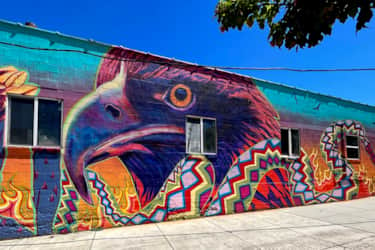
Razorback Sucker Mural
25 E Center Street, Moab
The Wildlife Walls trail continues in the heart of red rock country with a mural dedicated to the razorback sucker and the endangered fish of the Colorado River. The native razorback sucker, with its armor-like back ridge and golden belly, has survived in the Colorado River system for millions of years. But modern threats — dams, invasive species and habitat loss — have pushed it to the brink of extinction. The 20x30-foot mural at the Moab Information Center brings this little-known fish into the spotlight, educating visitors on the importance of the Colorado River system for local species.
You can try your luck viewing razorback suckers during spawning season (February–June) at the nearby Scott and Norma Matheson Wetlands Preserve, though you’re more likely to spot river otters, beavers and many kinds of birds.
From Moab, head northeast through Utah’s high desert for about 190 miles to reach Vernal, where fish take center stage again.
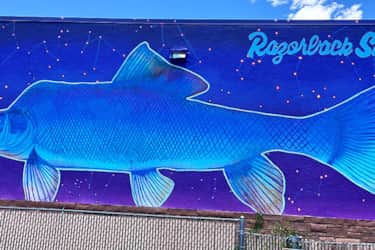
Dinosaurland Cutthroat Mural
74 E Main Street, Vernal
Vernal is famous for its dinosaurs, but the Colorado River cutthroat trout reminds visitors to appreciate the living species that still swim in local waters. This 140-foot-long mural features the Colorado River cutthroat trout, a fish with golden red flanks and the characteristic red throat slashes. Once pushed to near extinction by habitat loss and competition from non-native trout, this cutthroat is now making a slow but steady comeback in northeastern Utah’s alpine streams and creeks thanks to the work of Utah Division of Wildlife Resources and partners.
The best places to see these trout in the wild include Jones Hole Creek in Dinosaur National Monument and alpine streams in the Uinta Mountains.
From Vernal, follow US-40 west through the Uinta Mountains — about 130 miles — to reach Heber City, where bears and trout are up next.
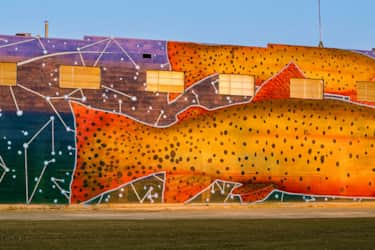
Bart the Bear Mural
81 S Main Street, Heber City
The Bart the Bear mural highlights Bart, a grizzly and a movie star who helped change how the public viewed his species. Trained in Heber and featured in major Hollywood films, Bart brought the strength and dignity of grizzlies to audiences around the world. The mural in downtown Heber honors Bart’s legacy, as well as the Vital Ground Foundation, which continues his work by protecting key bear habitats across the West.
Grizzlies no longer roam Utah; the last known grizzly, Old Ephraim, roamed the mountains of Northern Utah. Visitors looking to connect with the history of the bears can hike to Old Ephraims gravesite in Logan Canyon.
From Bart’s mural, head a few blocks down to find the Foam is Home mural.
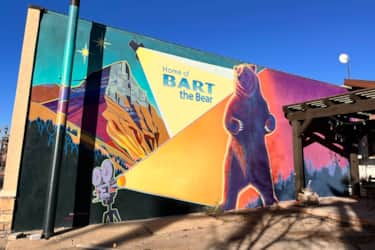
Foam is Home Mural
53-1 E 4th S, Heber City
The Foam is Home mural celebrates the brown trout, a species beloved by anglers and firmly established in Utah’s rivers, though not native. The artwork shows two trout swirling through foamy, rushing water, a nod to the phrase “foam is home” — a tip anglers use to spot good fishing spots. Brown trout, brought from Europe in the 1880s, have thrived in Utah’s cold streams, often outcompeting native fish like cutthroats. They are more likely to tolerate warming waters and may become more prevalent in Utah waterways as the climate continues to change.
You can spot brown trout in the nearby Provo and Weber Rivers, or book a trip with Heber’s Fish Heads Fly Shop for a guided fly-fishing experience.
From Heber, head north about 100 miles to reach Logan.
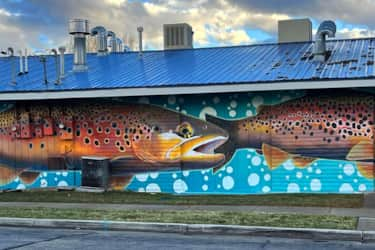
Bear River Cutthroat & Little Logan River Tunnel Mural
245 E 100 S, Logan
The Little Logan River Tunnel mural wraps around a river tunnel and brings together an impressive lineup: Bear River cutthroat trout, monarch butterflies, white-faced ibis, fireflies and Old Ephraim — the legendary Utah grizzly bear. The mural’s flowing lines and bright colors echo the rhythms of the river and the changing of the seasons.
Bear River cutthroat trout are known for their aggressive feeding and silvery-blue sheen, while fireflies light up Logan’s riverbanks in synchronized flashes on summer nights. Monarch butterflies pass through the valley in late summer, relying on local milkweed to complete their migration to Mexico.
Walk the Logan River trail to spot native cutthroat trout, fireflies in June, or ibis flying low over nearby Cutler Marsh; in the right season, this mural’s species are all around you.
From Logan, make your way south about 300 miles to reach the warm deserts of St. George.
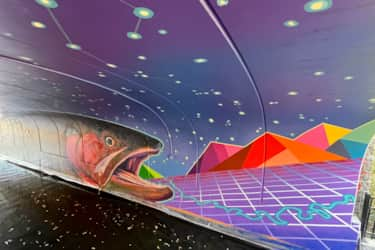
Desert Tortoise and Gila Monster Mural
151-135 N Main Street, St. George
The St. George desert mural features two icons of the region: the Mojave desert tortoise and the Gila monster. Both are slow-moving, secretive creatures built to withstand the heat and dryness of Utah’s southern landscapes. The desert tortoise can live up to 80 years, digging burrows that shelter many other species, while the Gila monster, North America’s only venomous lizard, relies on fat reserves in its tail to survive long stretches without food.
Your best bet for spotting these elusive reptiles is hiking the Tortoise Trail in Snow Canyon or visiting the Red Cliffs Desert Reserve, especially in spring and early summer.
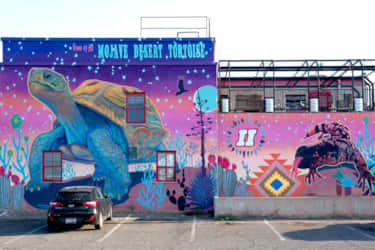
Why Wildlife Walls Matter
The Wildlife Walls Mural Trail reminds viewers what makes Utah unique. Some highlight comeback stories, like the Bonneville and Colorado River cutthroat trout. Others, like the relict leopard frog and the grizzly bear, remind us of what’s been lost — and what’s at risk if we don’t stay vigilant.
For an interactive map, exact mural locations and a wealth of nearby wildlife viewing opportunities to enhance your adventures, visit wildlifewalls.org.
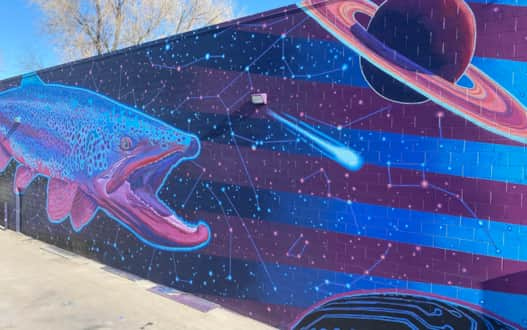
Space Trout & Utopia Mural Project
Photo: Utah Wildlife Walls/Chris Peterson

